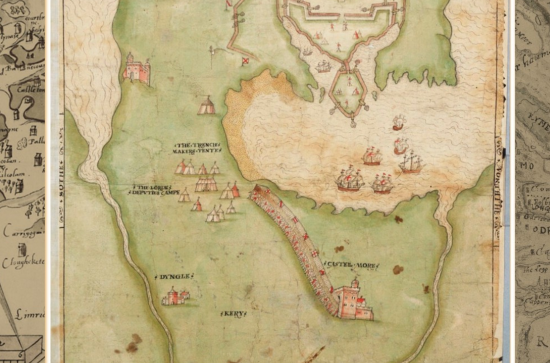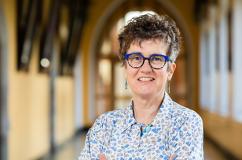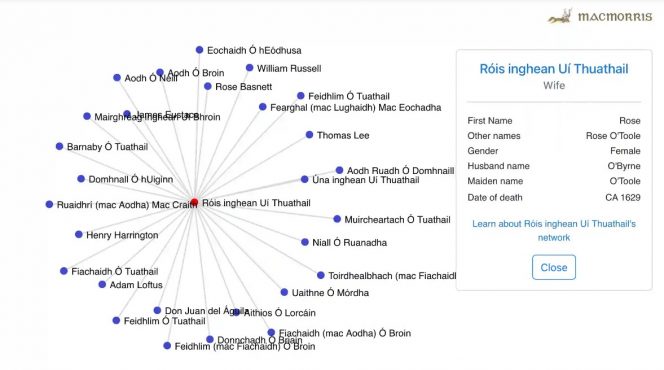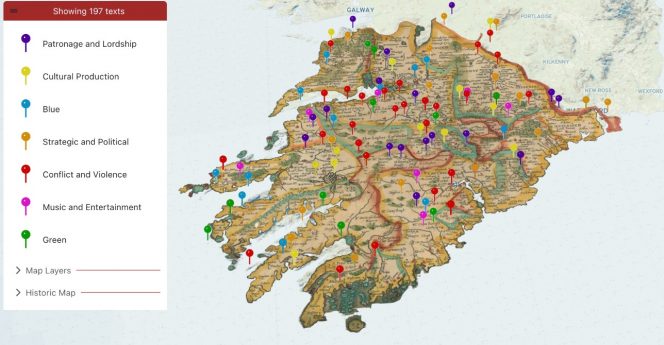
Cliceáil anseo chun dul go dtí an leagan as Gaeilge: Seoladh Thionscadal MACMORRIS: Acmhainn dhigiteach idirghníomhach don scoláireacht ar Éirinn sa Nua-Aois Luath

Developed by Maynooth University Professor Pat Palmer and a team of postdoctoral researchers, MACMORRIS is an acronym for Mapping Actors and Communities: Modelling Research in Renaissance Ireland in the Sixteenth and Seventeenth Century. It is a radically new digital-humanities project, which, for the very first time, maps the full range and richness of cultural activity in a time of change, conflict and, ultimately, transformation.
Funded as a four-year initiative by the Irish Research Council, MACMORRIS’s bilingual website gathers together the full range of voices and narratives which shaped modern Ireland.
The website assembles a cast list of all the players, a record of everything written in or about Ireland in the period and visualisations to allow users explore the complexity of those times. It offers biographical details on 4,762 figures from early modern Ireland. Among these are 1,004 writers, and an impressive collection of 4,631 works spanning English, Irish, Latin, Italian, Spanish, French, Welsh, Dutch, and German. The project's network-visualisation tool empowers users to explore connections between these key figures, revealing unexpected encounters between colonised and colonists, cultural actors and political players.

The interactive deep-map of Munster captures the vibrancy – and often the violence - that sprang from the enforced coexistence of planters and native lords, English poets and Irish bards, Italian commentators and Spanish captains. The inclusion of 199 extracts in six languages at 101 sites across the province immerses users in a world on the brink of profound transformation.

Pat Palmer, Professor of Renaissance English, who was awarded a grant of €1 million by the Irish Research Council's Advanced Laureate programme in 2019 to create this online resource, said: “MACMORRIS serves as a bridge between history and contemporary preoccupations, by recovering the lost complexity of early modern Ireland.
“By shedding light on the contending worldviews and narratives of a period of convulsive change, the project paves the way for a more comprehensive and inclusive understanding of our
present as well as our past.”
Sixteenth- and seventeenth-century Ireland shaped the emergence of modern Ireland. A watershed moment was the defeat of Hugh O'Neill's Confederates at Kinsale in 1601, which paved the way for the Plantation of Ulster and a new colonial order.
The transfer of lands from the native nobility – both Gaelic and Old English – to English and Scottish settlers created a new Protestant ascendancy. Consequently, Ireland became a testing ground for English overseas expansion and, simultaneously, one of the theatres of the emerging British Empire.
English gradually asserted itself as the language of power, resulting in the decline of Gaelic cultural institutions, including schools of poetry, law, and medicine. The gradual process of anglicisation changed ways of seeing the world which the project brings back into circulation.

All too often, this complex and uncomfortable story is told only through English-language writings. MACMORRIS provides the resources for uncovering richer, more inclusive accounts of early modern Ireland, by highlighting the dynamic responses of Gaelic culture to the unfolding events and reintroducing diverse voices and perspectives, in Irish and other languages.
The MACMORRIS project team includes Dr Evan Bourke, Dr Deirdre Nic Chárthaigh, Dr Philip Mac a’ Ghoill, Rupavathi Subramani and Alan Waldron.
The launch of the MACMORRIS website offers a holistic understanding of early modern Ireland and ensures that all the voices that shaped its history can join a conversation about the period that, more than any other, shaped our present.
For more information, please visit the MACMORRIS project website at https://macmorris.maynoothuniversity.ie/
--
Seoladh Thionscadal MACMORRIS: Acmhainn dhigiteach idirghníomhach don scoláireacht ar Éirinn sa Nua-Aois Luath

Forbartha ag an Ollamh Pat Palmer agus grúpa taighdeoirí iardhochtúireachta de chuid Ollscoil Mhá Nuad, is acrainm é teideal an tionscadail – MACMORRIS: Mapping Actors and Communities: Modelling Research in Renaissance Ireland in the Sixteenth and Seventeenth Century. Is tionscadal ceannródaíoch sna daonnachtaí digiteacha é a bhfuil sé i gceist aige an chastacht agus an ilghnéitheacht chultúrtha ar fad a bhaineann leis an tréimhse seo a léiriú don chéad uair, tréimhse a bhí lán le hathruithe, le coinbhleacht agus, ar deireadh thiar, claochlú na tíre.
Is tionscadal ceithre bliana é maoinithe ag an Chomhairle um Thaighde in Éirinn, agus tá réimse leathan guthanna agus peirspictíochtaí tugtha le chéile ar shuíomh MACMORRIS ó na daoine sin a bhí ar an saol nuair a bhí an tír ag athrú ó bhonn.
Tugann an suíomh liosta le chéile de na daoine seo chomh maith liosta de gach rud a scríobhadh faoi nó in Éirinn sa tréimhse sin. Is féidir uirlisí léirshamhlaithe a úsáid le castacht na mblinata sin a chuardach. Tugtar cuntais bheathaisnéise ar 4,762 duine a bhí ar an saol in Éirinn sa Nua-Aois Luath. Ina measc sin tá 1,004 scríbhneoir, agus bailiúchán suntasach de 4,631 saothar sa Ghaeilge, Béarla, Laidin, Iodáilis, Spáinnis, Fraincis, Breatnais, Ollainnis, agus Gearmáinis. Is féidir le húsáideoirí úsáid a bhaint as an uirlis léirshamlaithe líonraí le nascanna idir daoine éagsúla a fheiceáil, a léiríonn ceangail nach mbeifí ag súil leo idir coilínigh agus dúchasaigh, idir lucht na gcultúr agus lucht na polaitíochta.

Léiríonn an Léarscáil Dhomhain idirghníomhach de Chúige Mumhan an bheocht – agus go minic an foréigean – a tháinig as na dreamanna éagsúla ag teacht le chéile, coilínigh agus dúchasaigh, filí Sasana agus filí na nGael, tráchtairí ón Iodáil agus captaein ón Spáinn. Tá 199 sliocht i sé theanga ag 101 suíomh i gCúige Mumhan a thugann léargas dúinn ar shaol ar tí claochlú iomlán.

Seo a bhí le rá ag Pat Palmer, Ollamh le Renaissance Sasana, ar bhronn an Chomhairle um Thaighde in Éirinn €1 milliún uirthi in 2019 leis an acmhainn dhigiteach seo a chruthú: “Is droichead é MACMORRIS idir an stair agus buaireamh comhaimseartha, a thugann ar ais castacht na hÉireann sa Nua-Aois Luath a rinneadh dearmad uirthi.
“Trí sholas a chaitheamh ar dhearcthaí agus ar chuntais éagsúla ón tréimhse seo a bhí lán le hathruithe, tugann an tionscadal modh oibre dúinn le tuiscint níos ionchuimsithí a fháil ar an am i láthair agus ar an stair."
Síolraíodh Éire an lae inniu ó Éirinn an 16ú/17ú haois. Eachtra ríthábhachtach ab ea an bua a fuarthas ar fhórsaí Aodha Uí Néill i gCath Chionn tSáile in 1601, a réitigh an bealach do Phlandáil Uladh agus d'ord nua coilíneach.
D'aistríodh talamh na seanaicme dúchasaí – de chuid na nGael agus na Sean-Ghall – go dtí na coilínigh as Sasana agus Albain agus tháinig an Protastúnachas chun tosaigh. Ina dhiaidh sin, rinneadh láthair thástála d'Éirinn do leathnú chumhacht Sasana thar lear agus, ag an am céanna, bhí a háit mar chuid d'Impireacht na Breataine ag teacht chun cinn.
Tháinig an Béarla chun tosaigh mar theanga na n-uasalaicmí, agus tháinig meath ar sheanchórais chultúrtha na nGael, scoileanna filíochta, dlí agus leighis ina measc. Trí phróiseas an ghalldaithe thar na blianta, rinneadh dearmad ar pheirspicíochtaí eile, agus tá sé i gceist ag an tionscadal iad a thabhairt ar ais sa dioscúrsa.

Go rómhinic, bunaítear an tuiscint atá againn ar an tréimhse chasta mhíchompordach seo ar fhoinsí Béarla amháin. Tugann MACMORRIS cuntais níos ionchuimsithí agus níos saibhre ar Éirinn sa Nua-Aois Luath trí aird a thabhairt ar fhreagraí na nGael ar an mhéid a bhí ag titim amach thart orthu, agus trí ghuthanna i dteangacha agus ó pheirspictíochtaí éagsúla a thabhairt san áireamh.
Ag obair ar thionscadal MACMORRIS bhí Dr Evan Bourke, Dr Deirdre Nic Chárthaigh, Dr Philip Mac a’ Ghoill, Rupavathi Subramani agus Alan Waldron.
Anois go bhfuil an suíomh MACMORRIS seolta, tá teacht againn ar thuiscint iomlánaíoch ar Éirinn sa Nua-Aois Luath agus cinntíonn sé go dtabharfar aird ar na guthanna ar fad a dhear stair na tíre agus a dhear an t-am i láthair.
Is féidir tuilleadh eolais a fháil ar shuíomh gréasáin MACMORRIS: https://macmorris.maynoothuniversity.ie/
